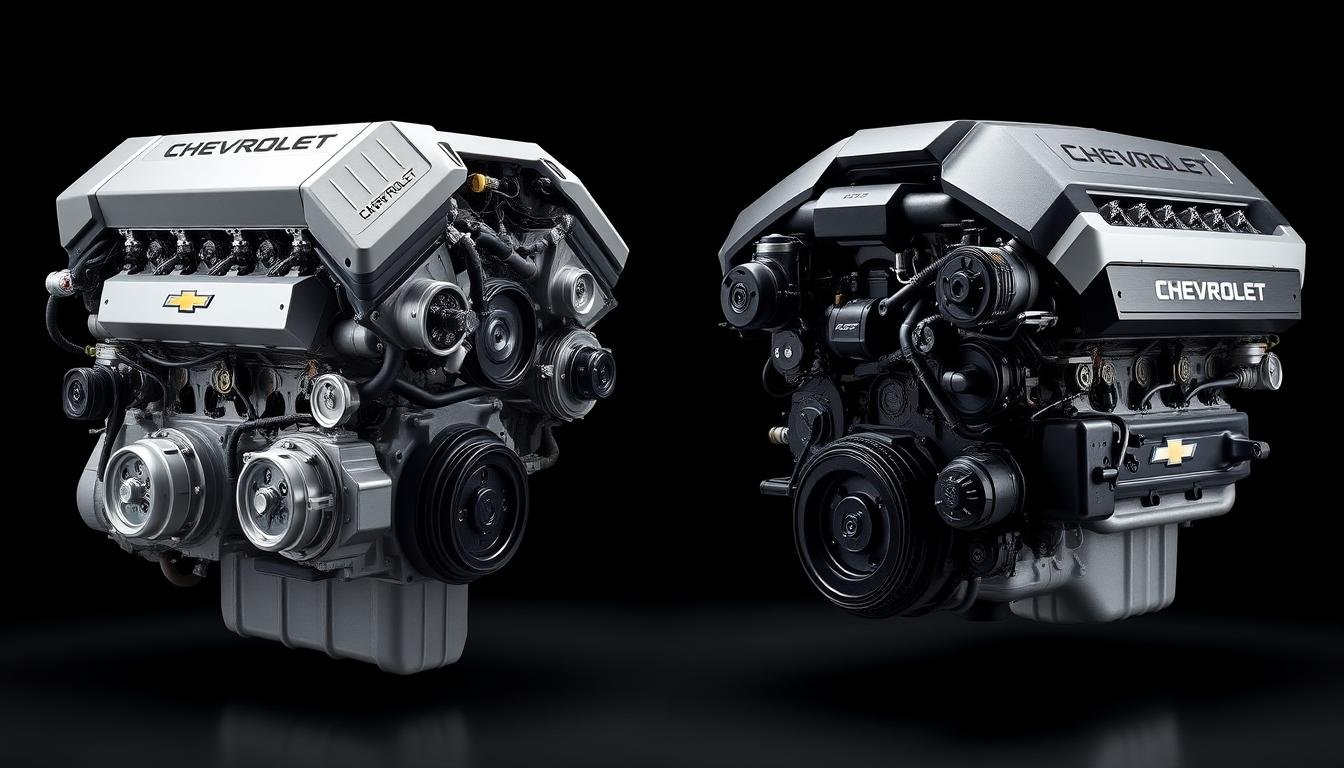Chevy 5.3 vs 6.2: Engine Showdown Comparison
The Chevy 5.3 and 6.2 engines are two major options in Chevrolet’s lineup. Knowing the differences between them is key for you as a driver.
In this comparison, we’ll look into what sets the Chevy 5.3 and 6.2 apart in terms of performance.
The 5.3L EcoTec3 engine has 335 horsepower and 383 lb-ft of torque. On the other hand, the 6.2L engine boosts to 420 horsepower and 460 lb-ft of torque.
This makes the 6.2L a top pick for those seeking top-notch performance. In this article, we’ll compare these engines in areas like fuel efficiency, towing capability, reliability, and user feedback.
The 5.3 engine gets about 20 MPG, making it good for everyday drives. Meanwhile, the 6.2 engine, getting 15-17 MPG, excels in heavy towing tasks.
By the end, you’ll know which engine fits your life best, matching your need for power, efficiency, or both.
Let’s dive into the Chevy 5.3 vs 6.2 engines to guide your choice with your driving style in mind.
Overview of Chevy Engine Options
Chevy offers a wide range of engines in its vehicles. The 2024 Chevrolet Silverado 1500 includes three main engines for various needs.
Knowing what each engine offers helps you pick the right one for you.
Introduction To Chevy’s Engine Lineup
The 2024 Silverado has a 2.7L TurboMax engine with 310 horsepower. It’s great for everyday use and can tow up to 9,500 pounds.
Then, there’s the 5.3L ECOTEC3 V8. It has 355 horsepower and can tow 11,300 pounds, perfect for heavier tasks.
Last in line is the powerful 6.2L ECOTEC3 V8 engine. It has 420 horsepower and supports towing up to 13,300 pounds. This one is meant for those needing top strength.
What is The Versatility of Chevy Engines?
Chevy engines offer a choice for every driver’s needs. You can find an engine that matches your driving style perfectly.
Whether it’s fuel efficiency, comfort, or power for hauling, Chevy has you covered.
| Engine TypeHorsepowerTorque (lb-ft)Towing Capacity (lbs)Payload Capacity (lbs) | ||||
|---|---|---|---|---|
| 2.7L TurboMax | 310 | 430 | 9,500 | 2,260 |
| 5.3L ECOTEC3 V8 | 355 | 383 | 11,300 | 2,180 |
| 6.2L ECOTEC3 V8 | 420 | 460 | 13,300 | 1,980 |
Chevy 5.3 vs 6.2: Performance Comparison
When comparing the Chevy 5.3 and 6.2 engines, you’ll see they each have unique traits.
These differences, especially in horsepower and torque, are critical. They help you choose what suits your needs best.
Horsepower and Torque Analysis
The comparison of horsepower chevy 5.3 vs 6.2 is eye-opening. The 5.3 engine offers 355 horsepower and 383 lb-ft of torque.
Meanwhile, the 6.2 engine steps things up with 420 horsepower and 460 lb-ft of torque.
This significant increase in power makes the 6.2 engine a top choice for those seeking peak performance.
The torque chevy 5.3 6.2 comparison shows the 6.2 not only beats the 5.3 in numbers but also in quick response when speeding up.
Acceleration and Engine Response
How quickly a car picks up speed is crucial. The performance differences chevy 5.3 and 6.2 are seen in faster launches and sharper engine response.
The 6.2’s extra torque means it responds better under pressure, like when carrying heavy loads or towing. This gives a more thrilling drive and confidence in many situations.
To wrap it up, the Chevy 5.3 and 6.2 engines differ greatly in horsepower and torque. This shows why the 6.2 engine is better in terms of strength and quick action.
Towing Capacity: Chevy 5.3 vs 6.2
Choosing between Chevy 5.3 and 6.2 engines for towing is vital. The 6.2L V8 engine, with the Max Trailering Package, can tow up to 13,300 pounds.
Meanwhile, the 5.3L offers a towing capacity of about 11,600 pounds. If power for hauling is your main concern, the 6.2 engine wins.
Comparing Power For Hauling
The 2022 Chevy Silverado 1500 with a 6.2L engine and Max Trailering Package is powerful for towing.
You can choose this engine with different body styles, such as Crew Cab Short Bed and Double Cab Standard Bed.
It’s available in both 2WD and 4WD. This setup is proven for towing in many conditions.
Real-World Towing Performance
Owners praise the 6.2L engine’s towing capability. One person boasted about towing a 6,000-lb boat through tough terrain.
They said, “The truck has the guts and handles beautifully in the mountains.” This shows the engine’s strength for heavy-duty tasks. Many note the 6.2L engine’s better torque and horsepower.
A forum user stated, “With a 10-speed transmission and 20% more torque/HP, the 6.2L outperforms the 5.3L.” This highlights the 6.2L engine’s superior towing power.
| Engine Type | Maximum Towing Capacity (lbs) | Typical Uses |
|---|---|---|
| 5.3L V8 | 11,600 | Light to moderate towing (trailers, boats) |
| 6.2L V8 | 13,300 | Heavy towing (large trailers, work equipment) |
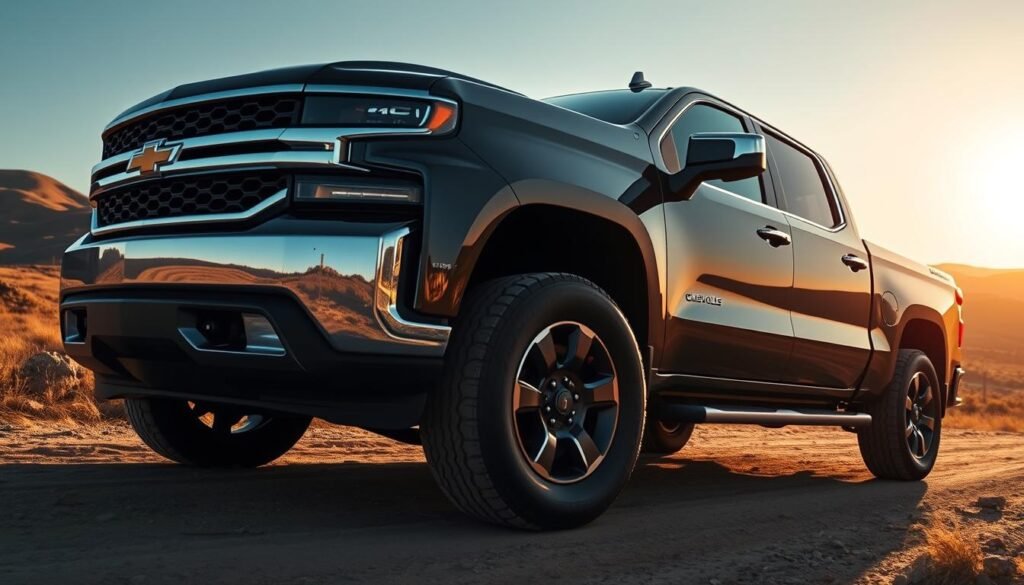
Fuel Efficiency Comparison: Chevy 5.3 and 6.2
Fuel efficiency matters a lot for truck owners, especially if they drive every day. The fuel mileage of Chevy engines in the city and on highways influences whether you choose the 5.3L or the 6.2L engine.
Knowing these ratings helps you weigh the cost of fuel against how each engine performs.
City and Highway Mileage Ratings
The 2020 Chevrolet Silverado’s 5.3L V8 engine gets good fuel mileage. The 2WD models get about 15 MPG in the city and 21 MPG on the highway.
This equals an overall rating of 17 MPG. The 4WD versions do nearly as well, with 15 MPG in the city and 20 MPG on the highway.
Meanwhile, the 6.2L V8 engine, seen in the 2014 Chevrolet Silverado and GMC Sierra, is a bit less efficient.
The 2WD versions manage 15 MPG in the city and 21 MPG on the highway. The 4WD models get from 14 MPG in the city to 20 MPG on the highway.
| Engine Type | City MPG | Highway MPG |
|---|---|---|
| 5.3L V8 (2WD) | 15 MPG | 21 MPG |
| 5.3L V8 (4WD) | 15 MPG | 20 MPG |
| 6.2L V8 (2WD) | 15 MPG | 21 MPG |
| 6.2L V8 (4WD) | 14 MPG | 20 MPG |
Impact of Engine Choices on Fuel Economy
Choosing between the 5.3L and 6.2L engines means balancing fuel savings and power.
The 5.3L V8 does slightly better, with 1 MPG more in the city and 2 MPG more on the highway than the 6.2L V8.
If saving fuel is your priority, the 5.3L engine is the smarter choice. The two engines also use Active Fuel Management (AFM) tech.
This helps them save gas by turning off four cylinders when they’re not needed. So, both engines can save fuel but still deliver power when you need it, making them more fuel-efficient.
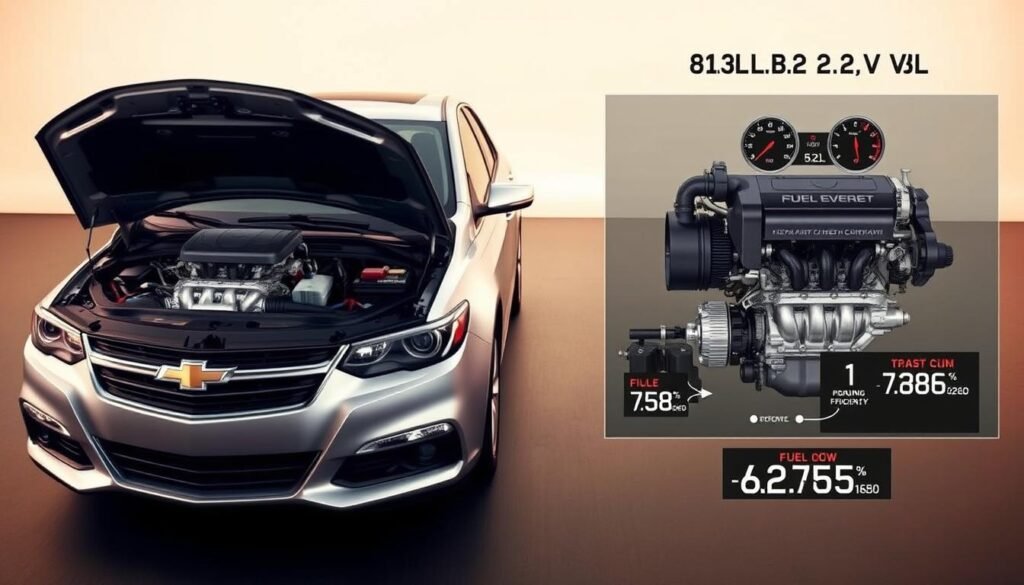
Reliability Factors in Chevy 5.3 and 6.2 Engines
When looking at Chevy engines, reliability is key. The comparison between chevy 5.3 vs 6.2 reliability shows each one’s good and bad points.
Knowing about the usual complaints and how much they cost to fix will help you choose the best one for you.
Common Complaints and Longevity
The 5.3L engine is known for lasting a long time. Many people say it works well for more than ten years. But as it gets older, it might use a little more oil than usual.
The 6.2L engine offers more power but can be more complicated. This complexity might cause more wear on parts.
Yet, both engines are praised for their dependable performance over the years.
Maintenance Costs and Resale Value
Maintaining a 6.2L engine usually costs more because of its high-end parts. In comparison, the 5.3L engine is cheaper to keep up and fix. However, trucks with either engine keep their value well.
But, the 6.2L tends to sell for more because of what it offers. Truck lovers particularly value its power and features.
| Engine Type | Common Complaints | Maintenance Costs | Resale Value |
|---|---|---|---|
| 5.3L | Minor oil consumption | Lower than 6.2L | Good |
| 6.2L | Higher wear on components | Higher due to complexity | Premium pricing |
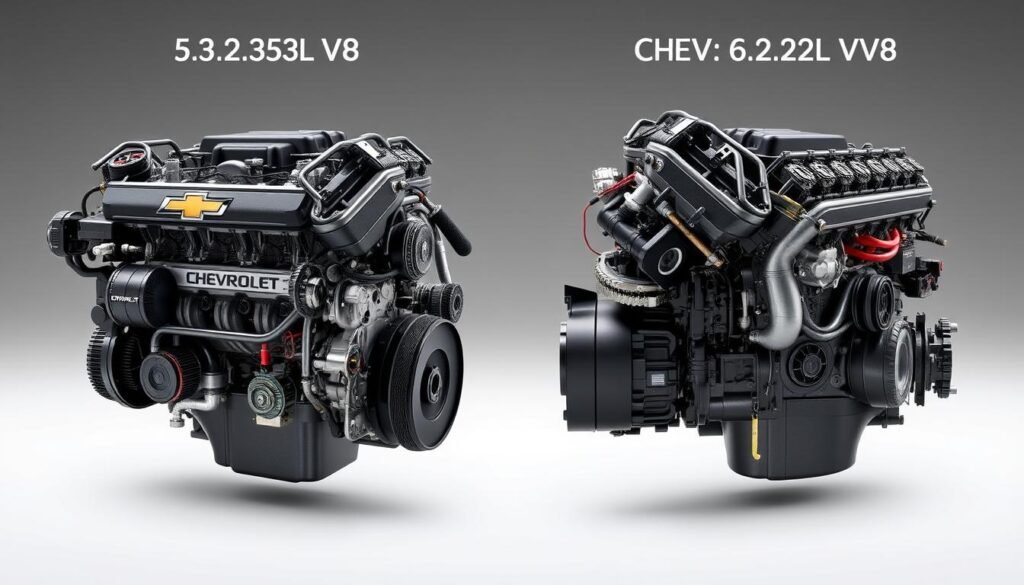
Technology Features in Chevy 5.3 and 6.2 Engines
Chevy is big on adding technology to its 5.3 and 6.2 engines. This smart move boosts both the performance and mileage of the vehicles.
With things like direct fuel injection, variable valve timing, and Active Fuel Management, your drive gets better without using more gas.
Engine Management and Performance Enhancements
The engine management systems are key to how Chevy engines perform. They check different factors to keep the engine running at its best.
Thanks to cutting-edge tech, these engines give you great benefits:
- Direct fuel injection makes burning fuel more efficient.
- Variable valve timing increases power at any speed.
- Active Fuel Management cuts down on gas use when it’s not needed.
Modern Tech Integration in Chevy Trucks
Chevy’s upgrade isn’t just about the engines. It’s also about making trucks with the latest tech for a top-notch driving experience.
They have added features such as:
- Entertainment systems that connect to your smartphone for music and maps.
- Driver assistance tools for safer and easier driving.
- Advanced diagnostics to keep an eye on engine performance and health.
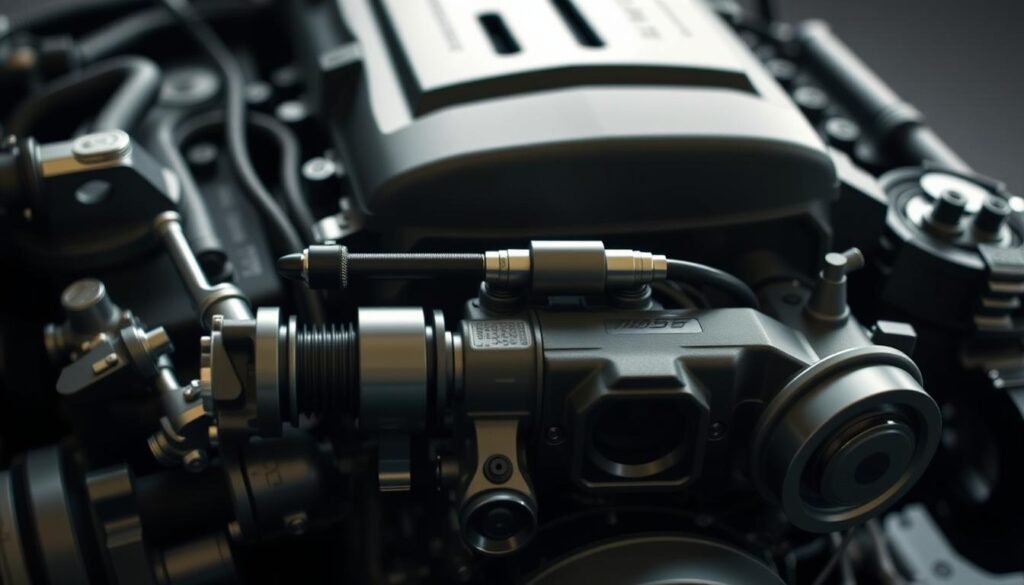
Chevy 5.3 vs 6.2: User Experience and Reviews
Users’ opinions are key to knowing if Chevy’s 5.3 and 6.2 engines are good. Many love the 5.3 for its steady work and less gas use, making it great for daily use.
It’s liked for its even performance and enough strength. Meanwhile, the 6.2 engine gets kudos for quick speed and pulling power, perfect for off-road and heavy jobs.
Owner Feedback and Preferences
Many reviews show a preference for the 5.3 engine for everyday driving. It’s seen as powerful yet efficient with fuel. Owners also enjoy its reliable and smooth running.
Real-World Driving Experiences
6.2 engine users, however, enjoy its power for tough jobs. It’s a top pick for towing and carrying big loads.
People who need more strength find that the 6.2 engine meets their needs. It excels in handling heavy weights without trouble.
Comparative Analysis of Engine Choices
Choosing the best engine for your vehicle starts with knowing your driving needs. The Chevy 5.3 and 6.2 engines each have their own benefits, meeting different needs.
This comparison highlights important factors to think about when deciding between the two.
When To Choose 5.3 over 6.2
If you care most about fuel efficiency and reliability for daily use, the Chevy 5.3 engine is the better choice.
It offers great fuel savings and is perfect for regular driving without heavy towing or off-roading.
Choosing the 5.3 engine makes sense for those who want to save money and mainly drive around town.
Learning Your Driving Needs
Your driving habits are key in deciding which engine suits you best. For those who often carry heavy loads or enjoy off-roading, the Chevy 6.2 has the power you need.
It’s great for tough jobs and fun outdoor activities because of its higher torque and horsepower.
Thinking carefully about your usual driving can help you choose wisely between the Chevy 5.3 and 6.2.
| Feature | Chevy 5.3 | Chevy 6.2 |
|---|---|---|
| Power Output | 355 hp | 420 hp |
| Torque | 383 lb-ft | 460 lb-ft |
| Fuel Efficiency (Combined) | 17-21 MPG | 15-19 MPG |
| Typical Use | City commuting, light loads | Heavy towing, off-road activities |
Conclusion
In wrapping up the Chevy engine debate, we see that the 5.3 and 6.2 engines each have their own pros.
The 5.3 is known for being reliable and good on gas, which is great for everyday use. It offers enough power for your day-to-day needs, balancing efficiency and performance well.
The 6.2 engine, however, is a star in terms of power and strength, making it perfect for towing and carrying heavy loads.
If you often find yourself on rough terrains or hauling big items, the 6.2 is your go-to engine.
Choosing between the Chevy 5.3 vs 6.2 depends on what you need from your vehicle. Think about how you plan to use your car to pick the best engine for your lifestyle.
FAQs
What is the difference in horsepower between the Chevy 5.3 and 6.2 engines?
The Chevy 5.3 engine produces 355 horsepower. Meanwhile, the 6.2 engine generates a powerful 420 horsepower. This gives the 6.2 engine significantly better performance.
How do the towing capacities of the Chevy 5.3 and 6.2 compare?
The Chevy 5.3 can tow up to 11,600 lbs. On the other hand, the 6.2 can handle up to 13,300 lbs. This makes the 6.2 more suitable for hauling heavy loads.
What are the fuel efficiency ratings for the Chevy 5.3 and 6.2 engines?
The 5.3 engine offers 16-18 MPG in the city and 22-24 MPG on the highway. The 6.2 engine, however, gets 15-17 MPG in the city and 20-23 MPG on the highway.
Which engine is more reliable, the 5.3 or the 6.2?
Both engines are reliable. Yet, the 5.3 is noted for its durability and fewer issues. The 6.2 may require more maintenance due to its complexity.
How does acceleration differ between the Chevy 5.3 and 6.2 engines?
The 6.2 engine accelerates faster with improved throttle response compared to the 5.3. It is better for those who want quicker starts.
What technology advancements are present in both engine options?
Both engines have direct fuel injection, variable valve timing, and Active Fuel Management. These technologies boost performance and fuel efficiency.
Which engine is better for off-road driving?
For off-road driving, the 6.2 engine stands out with its superior power and torque. It performs better in demanding terrains.
How do user experiences with the Chevy 5.3 and 6.2 differ?
5.3 owners like its reliability for daily use. 6.2 owners, however, praise its high power and towing ability for work and fun.
What should I consider when choosing between the 5.3 and 6.2 engines?
Think about your driving needs. Choose the 5.3 for efficient daily commuting. Pick the 6.2 for heavy-duty tasks and top performance.

